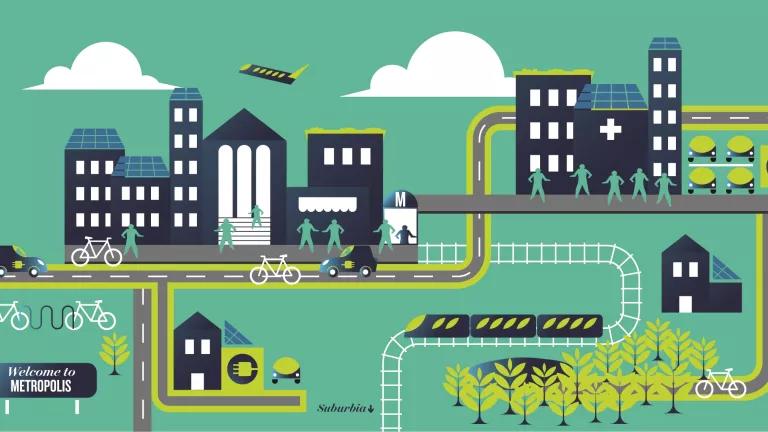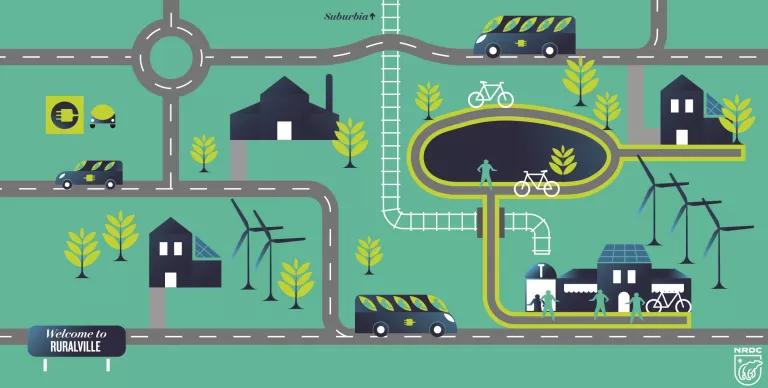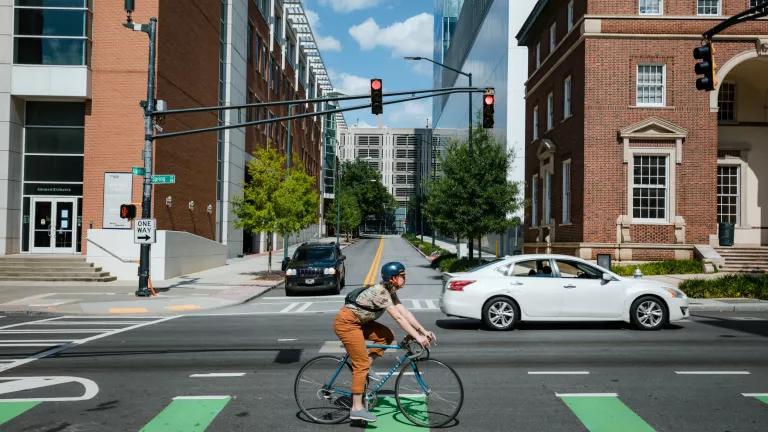Reimagining Transportation in the Northeast and Mid-Atlantic

In 2017, at the Bonn Climate Conference, a bipartisan group of Northeastern and Mid-Atlantic state governors and the mayor of Washington, D.C. pledged to work together to develop a regional plan to clean up and modernize transportation—the ways we move people and goods in the region. Today, NRDC is releasing a new report, Transportation Reimagined: A Roadmap for Clean and Modern Transportation in the Northeast and Mid-Atlantic Region, to help the states—and their citizens—fulfill this promise.
Nearly everyone has a transportation tale of woe. From tailpipe pollution and traffic jams to crumbling infrastructure; buses and trains that don’t get us where we need to go when we need to get there; and streets that are unsafe for pedestrians and cyclists, our transportation system is in need of a serious makeover.
In the Northeast and Mid-Atlantic region:
- Traffic congestion in our five most congested cities—New York, Boston, Philadelphia, Washington, D.C., and Stamford, Connecticut—costs the economy $50 billion a year.
- Tailpipe pollution from cars and trucks causes 51,000 asthma attacks, 220,000 lost work days, and as many as 3,600 premature deaths a year.
- In 2016, more than 1,000 pedestrians and cyclists lost their lives on the region’s roads.
- Drivers spend $50 billion a year on gasoline at the pump, sending our transportation dollars out of state for oil produced outside the region and abroad.
- And transportation is the largest source of climate-changing greenhouse gas emissions.
Many rural and low-income residents face higher transportation costs for fewer, less accessible transportation options. Pollution hotspots in heavy transportation areas disproportionately sicken low-income communities and communities of color.
NRDC’s report provides a roadmap for solving these problems through proven strategies that will make transportation more equitable, more accessible, more affordable, and cleaner too. Such strategies include investing in safe, walkable and bikeable streets; better public transit; affordable, transit-oriented housing; and clean electric vehicles powered by renewable energy.
By modernizing transportation, we can increase the livability of our communities and make the Northeast and Mid-Atlantic region the envy of the country, if not the world. With Transportation Reimagined, we help show states and citizens how to get there.
Modernizing Transportation
Transportation Reimagined focuses on modernizing transportation in 11 states—Connecticut, Delaware, Maine, Maryland, Massachusetts, New Hampshire, New Jersey, New York, Pennsylvania, Rhode Island, and Vermont—and Washington, D.C. Since 2010, these 12 jurisdictions have participated in a multistate collaborative known as the Transportation and Climate Initiative (TCI), dedicated to finding clean transportation solutions.
Eight of these jurisdictions—the ones that pledged to work together in Bonn last year—are currently holding a series of public listening sessions to take input on developing a clean transportation plan for the region. The next listening session will be in New York City on July 24.
Rural, Suburban, and Urban Solutions
NRDC’s report contributes to this discussion by exploring strategies for modernizing transportation that have been piloted around the country—in rural, suburban, and urban communities—and could be implemented more broadly.
These strategies include expanding public transit and electric vehicle infrastructure in rural areas; expanding commuter rail and safe, walkable and bikeable streets in the suburbs; and investing in equitable, transit-oriented development and electric bus fleets in cities.

Our report also explores the benefits of modernizing the region's transportation, including:
- Reducing soot pollution from cars and trucks by one percent would save dozens of lives, prevent thousands of respiratory ailments, and save the region hundreds of millions of dollars a year. Eventually eliminating these emissions would avoid $35 billion in annual health costs.
- Lowering traffic congestion to speed up travel by just one mile per hour would provide nearly $19 billion a year in benefits through time savings, reduced fuel use, lower pollution impacts, and lower costs of doing business.
- Reducing gasoline use by switching to electric vehicles and providing alternatives to personal vehicles could save residents more than $100 billion at the pump through 2035.
- Investing in clean and modern transportation measures that cut carbon pollution from transportation 40 percent could create 125,000 jobs and add $17.7 billion a year to the region’s economy by 2030.
Time to Get This Show on the Road
Building a clean and modern transportation system will require a strong commitment to invest in our transportation system, including new infrastructure and cleaner vehicles.
But as Northeast and Mid-Atlantic states have shown, we can accomplish this task by modernizing and growing our economy together. Through the groundbreaking Regional Greenhouse Gas Initiative, states in this region have already cut carbon pollution from power plants in half over the last decade while growing the economy, creating jobs, and driving investment in clean and renewable energy.
We have the policy models and tools to accomplish a similar revolution in transportation, and the benefits of doing so will be well worth the effort.
NRDC urges residents, businesses, and state and municipal leaders to reimagine what our transportation system could be and boldly chart a course for our future. With planning, vision, and commitment, we can create a clean, efficient, reliable, resilient, and equitable transportation system for the 21st century.



